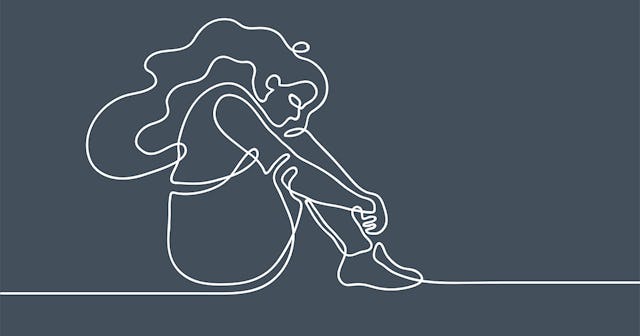I Finally Understand What It Means To Move Forward With Grief

I’ve lost count of how many well-meaning friends have forwarded me the TED Talk featuring Nora McInerny, author and founder of the Hot Young Widows Club. (If you’ve never heard of this club, consider yourself lucky. Despite the cute, tongue-in-cheek name, it’s the club no one wants to join. Admission is high — not attractiveness nor age, just a life-changing, devastating loss.) In her talk, Nora speaks to the idea that we never move on from our grief, we move forward with it.
“A grieving person is going to laugh again and smile again,” she says in her TED Talk. “They’re going to move forward. But that doesn’t mean that they’ve moved on.”
The concept seems clear enough. I’ve been widowed for 1,138 days. I’ve been a person intimately acquainted with grief for a bit longer than that, if I count the days when the doctors told me my young husband had weeks left to live, and I began to grieve the life we’d never have a chance to live. After all this time, I thought I understood what it meant to move forward, not move on.
If you’d asked me even a few days ago, I would have said I was moving forward with my grief. In the last three years, I’d bought a new house, started a new career (two, actually), and even started dating. I was allowing myself to feel joy and heartache on birthdays and anniversaries, allowing myself to say my husband’s name and remember the best and worst parts of our life together. I was doing exactly as Nora had suggested: moving forward with my grief in tow.
Only, I wasn’t. Not really. Because more and more, as I watched friends move forward in their lives, I felt like I was falling behind.
This past weekend, the man I’m dating (the word “boyfriend” still sounds strange, but for brevity let’s call him that) asked if I wanted to take my kids on a hike with him and his son. I readily agreed, for two reasons. One, I was happy to have a reason to separate my kids from their screens for a few hours. And two, I was navigating the final dregs of a particularly vicious grief wave that I couldn’t quite pin down and I thought the fresh air and change in pandemic routine would help.
I assumed hike meant walking along a well-worn path to reach a specific destination and then turning around. (Which explains why I thought it was okay to wear platform sneakers.) I assumed hiking meant what it had always meant.
But walking along the well-worn path is not what we did. About seven minutes into walking the well-worn path, my boyfriend took a hard right and began walking uphill through the trees. Not quite realizing what we were in for, my kids and I followed him.
Before we knew it, we were hopping rocks to cross streams, pulling ourselves up over boulders using tree branches, and sliding through narrow stone passageways. For the majority of the hike, I had no solid footing and no idea where we were going. Eventually, we found ourselves standing on top of a waterfall, looking down at all the hikers who’d taken the well-worn path. The path I’d always taken.
Something about the combination of a grief wave, a bloody knee caused by a jagged tree branch (because who wears platform sneakers on a hike?!), and a dizzying height, made the phrase “moving forward with grief” click in a new way. I realized in that moment something I should have long before: I had the “with grief” part down, but “moving forward” didn’t mean what I thought it meant.
I thought moving forward meant doing. And I had been doing — the house, the careers, the dating. But when I thought about it, all of that moving wasn’t exactly forward. I’d moved houses, sure, but I moved down the street. New house, same neighborhood. My running route hadn’t even changed.
I started two new careers, but both had been hobbies I’d invested time in prior to becoming a widow. Neither took me out of my comfort zone.
And while, dating was brand new (especially online dating — I’m still stunned by that world), in reality, I quickly backed away from any experience that required me to alter any part of my pre-loss life.
The reality was all of my steps forward were superficial. Rather than forward, I was shuffling side-to-side in my comfort zone, in a life I’d built with my husband. Even though he was gone. Even though the person I was with him was gone. And even though, for better or worse, my grief took up more space than that old life allowed and I knew I no longer fit.
It took literally veering right and walking into the unknown, walking into a situation I wasn’t prepared for, to make me see that “moving forward” is more than being capable of living and laughing again post loss. It is that, of course. Learning to laugh is the first step to moving forward with grief. But standing on top of that waterfall, I realized, “moving forward” also means more. It means acknowledging that your forward looks different than it did before loss — and grieving that fact. It means leaving in the past what no longer fits and embracing, fully, what does. Sometimes, it might even mean veering right, rather than going the way you know. (Even when you’re wearing completely inappropriate shoes.)
This article was originally published on